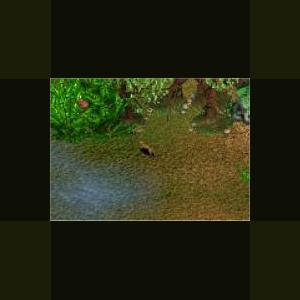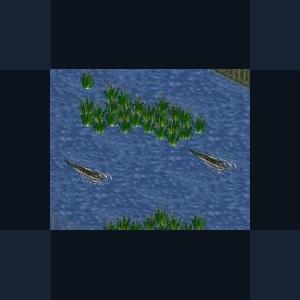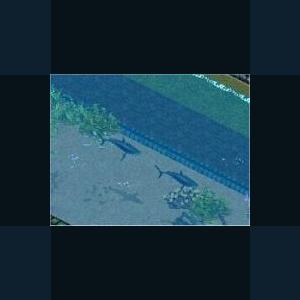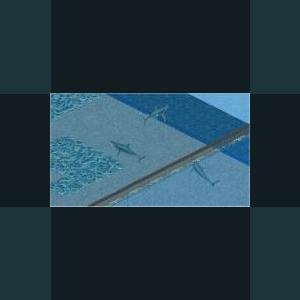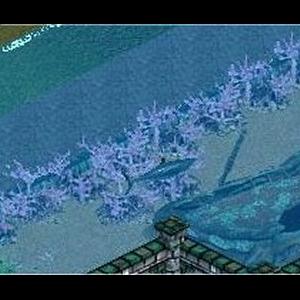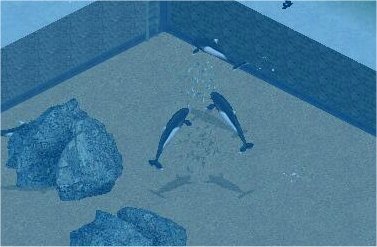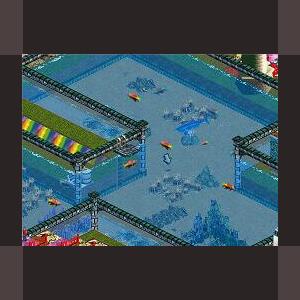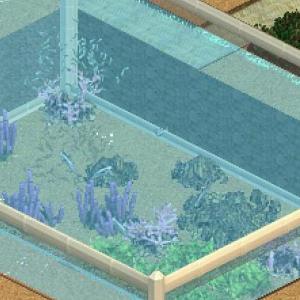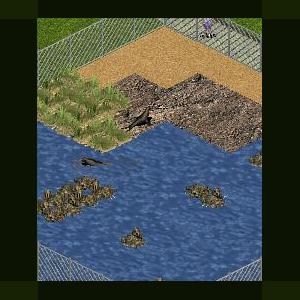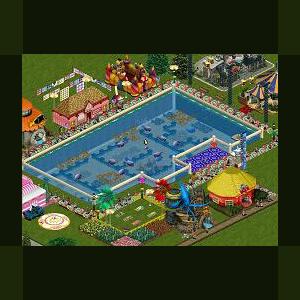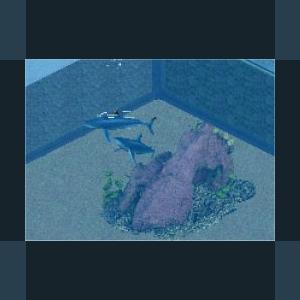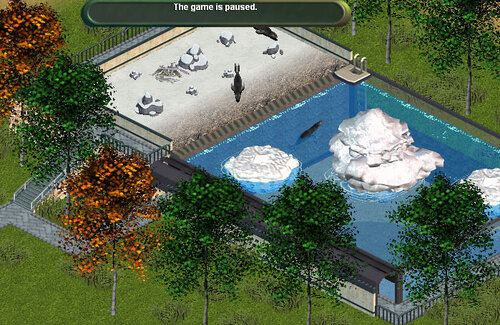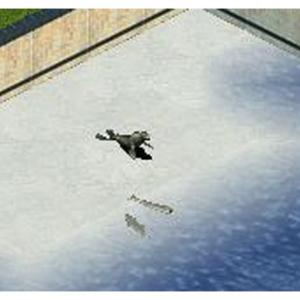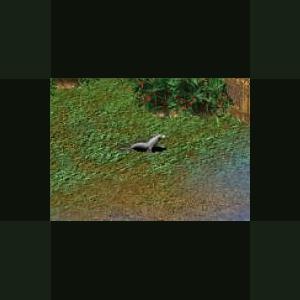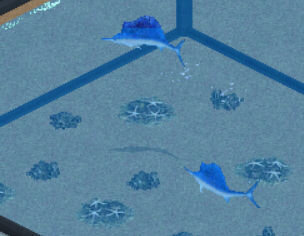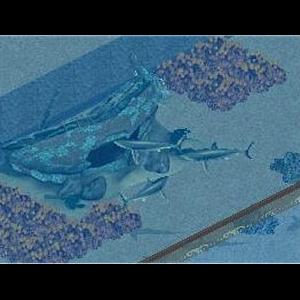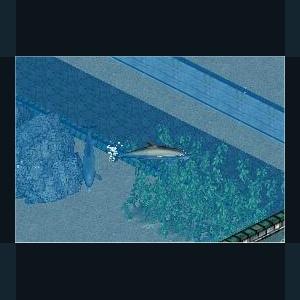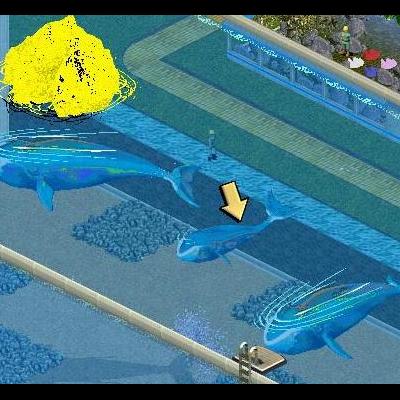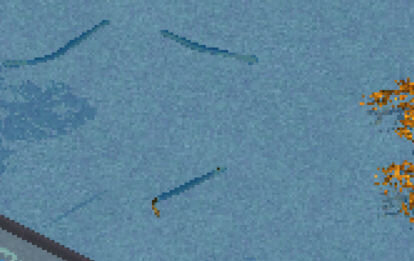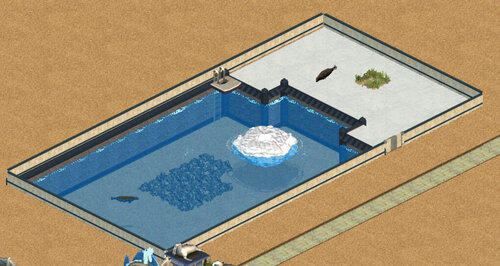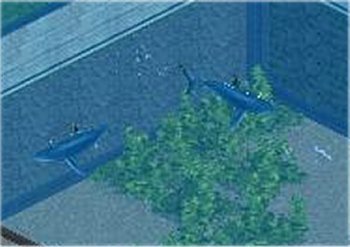Marine
Creatures under the sea
47 files
-
Otter Civet by Ghirin
By Guest
Otter Civet
Author: Ghirin
The otter civet (Cynogale bennettii) resides in swampy wetlands and borders of streams and rivers in tropical southeast Asia and Indonesia. It is semi-aquatic and resembles a small sea otter. The civet otter is thought to ambush small mammals and birds when they come to the water to drink; it may also eat crustaceans, mollusks, fish and fruit.
References:
Walker’s Mammals of the World. Nowak, 1999
Created by Ghirin 2003
387 downloads
0 comments
Updated
-
Orinoco Crocodile by Ghirin
By Guest
Orinoco Crocodile by Ghirin
The Orinoco crocodile (Crocodylus intermedius) is one of the largest predators found in South America.
At one time, this crocodile ranged from the northern coast of South America to the foothills of the Andes Mountains, but today its numbers have been severely reduced and it is critically endangered.
**Inspired by the Zoo Tycoon Brains Trust at the Zoo Tek Forums.
Reference:
http://www.flmnh.ufl.edu/natsci/herpetolog...cs/csp_cint.htm
383 downloads
0 comments
Updated
-
Dusky Shark by Ghirin
By Guest
Dusky Shark Author: Ghirin
The dusky shark (Carcharhinus obscurus) has a wide distribution among the coastlines of temperate and tropical regions, with major populations found in the western Atlantic Ocean, western Indian Ocean, Mediterranean Sea, Pacific coast, and Australian waters. This shark prefers the relatively shallow waters of continental shelves. Young dusky sharks may congregate in bays and estuaries; however, adult dusky sharks avoid areas of low salinity. Dusky sharks are highly migratory. The exact path of migration varies with specific shark populations and is seasonal in nature.
Dusky sharks prey on bottom-dwelling fish and invertebrates (i.e., skates, crabs, flatfish). They will also feed on pelagic fishes. Dusky sharks are viviparous with litter sizes ranging from 3 to 14 pups.
*Inspired by the Zoo Tycoon Brains Trust at the Zoo Tek Forums.
Created by Ghirin 2004
382 downloads
0 comments
Updated
-
Lemon Shark by Ghirin
By Guest
Lemon Shark Author: Ghirin
The lemon shark (Negaprion brevirostris) is a large shark that inhabits the coastal waters of the Atlantic ocean, primary the coasts of the Americas and western Africa. A second population is also found in the Pacific coastal waters off of North and South America.
Lemon sharks form loose, same-sex groups that may come inshore during the day, but usually return to deeper waters at night. They are often found near the bottoms of of the bodies of water where they feed on bony fishes and crustaceans.
This species of shark is viviparous, giving birth to live pups (litter size ranges 4-17 pups). The pups live in shallow waters for the first years before venturing out into deeper waters.
*Inspired by the Zoo Tycoons Brains Trust at the Zoo Tek Forums
Created by Ghirin 2004
380 downloads
0 comments
Updated
-
Saltwater Bull Shark by Ghirin
By Guest
Saltwater Bull Shark
Author: Ghirin
The bull shark (Carcharhinus leucas) is a large, robust shark found in shallow coastal marine waters worldwide. These sharks will also enter and live in estuaries, freshwater lakes and rivers.
Bull sharks eat both bony fishes and small sharks. In the cooler portions of their range, bull sharks mate during the summer months; however, in the warmer parts of their range they may breed year-round. Females nourish the young internally for 10 to 11 months and give birth to free-swimming pups.
*Inspired by the Zoo Tycoon Brains Trust at the Zoo Tek Forums.
Created by Ghirin 2004
377 downloads
0 comments
Updated
-
Dall's Porpoise by Ghirin
By Guest
Dall’s porpoise (Phocoenoides dalli), also known as the white-flanked porpoise, is a robust porpoise with a striking black and white piebald pattern. It is reported to be a fast cetacean (reaching speeds up to 55 km/hr for short periods) and regularly rides the bow waves of ships when the vessel is moving at a minimum of 26 km/hr. Dall’s porpoises are also known for sending up “rooster-tail” water sprays when they surface.
Dall’s porpoises are native to the northern Pacific Ocean and range from Japan to California. Unlike several other porpoise species, Dall’s porpoise is regularly reported in open oceanic waters. It often forms groups of two to twelve individuals, but these small schools have been known to merge into groups of several thousand.
Their diet consists mainly of squid, fish, and krill.
*Inspired by the Zoo Tycoon Brains Trust at the Zoo Tek Forums.
References:
Walker’s Mammals of the World. Nowak, 1999.
Animal: The Definitive Visual Guide the World’s Wildlife. Burnie and Wilson, 2001.
http://www.bbc.co.uk/nature/wildfacts/factfiles/128.shtml
Updated August 18, 2018 by Cricket so that screenshot would show up again.
Created by Ghirin 2004
365 downloads
0 comments
Updated
-
Cuban Hog Fish by JT (JohnRN1)
By Cricket
Thank you for downloading the Cuban Hog Fish. This colorful saltwater fish was made for the 2012 Tek Anniversary. Congratulations Tek.
"Move the .ztd file into the dlupdate (and not dupdate) folder if one exists in your Zoo Tycoon folder; otherwise move the .ztd file into the Updates folder that is in the Zoo Tycoon folder."
The default is C:\Program Files\Microsoft Games\Zoo Tycoon
Thank you to Fern and Jay for their invaluable encouragement, guidance and expertise.
--JohnT--
360 downloads
0 comments
Updated
-
Silver Carp by Ryno
By Guest
The silver carp (Hypophthalmichthys molitrix) is a species of freshwater cyprinid fish
351 downloads
0 comments
Updated
-
Galapogos Sea Lion by Jordan MK
By Guest
Genus: Zalophus
Species: californianus wollebaeki
Identification:
There are three subspecies of Zalophus californianus. The California sea lion (Z. c. californianus) is found from southern Mexico up to British Columbia and breeds almost entirely on islands in southern California, western Baja California and the Gulf of California. The Galápagos sea lion (Z. c. wollebaeki) is found on the Galápagos Islands and also occasionally in coastal Ecuador and Colombia. The Japanese sea lion (Z. c. japonicus) is now believed to be extinct but was formerly found in the Sea of Japan. Some scientists believe that these three subspecies should in fact be classed as separate species, namely Z. californianus, Z. wollebaeki, and Z. japonicus.
Population:
There is no up-to-date count of Galápagos sea lions, the last reported population estimate of 30,000 being made in the late 1970s.
Endangerment Status:
The Galápagos sea lion is listed as Vulnerable on the IUCN Red List. This subspecies was not subjected to the same commercial exploitation that caused the depletion of California sea lion populations, although occasional sea lions were killed for their skins or to provide tooth necklaces for tourists. Many Galápagos sea lions have been and are still being killed as a result of illegal and local fishing activities around the islands, despite the Ecuador government expanding the no-fishing zone around the islands from 15 to 40 nautical miles in early 1998. The entanglement of sea lions in fishing gear, particularly in long-line hooks and nylon line, is one of the most important problems currently affecting the subspecies. Entanglement in marine debris is an additional problem. Between 1995 and November 2000 a total of 111 reports of entangled sea lions were received.
El Nino:
Galápagos sea lions are badly affected by the lack of food availability and weather conditions produced by El Niño events. During the 1982-83 El Niño all Galápagos sea lion pups born in 1982 died, while only a third of the normal number of pups were born in 1983. During the 1997-98 El Niño, the Galápagos sea lion population showed a significant decline in almost all of its colonies, a 48% population decrease caused by both mortality and migration having been observed during this period. The most affected age range were pups born between June 1997 and December 1998, suffering a 90% mortality rate. The large male sea lions, especially the dominant sea lions during the 1998 breeding season, experienced a 67% mortality rate. During the El Niño event it was found that the sea lions tried to make up for the lack in prey by feeding on lantern fish (Myctophidae) rather than the usual sardines (Clupeidae), and exhibited behavioural changes such as foraging during the night. The mortality rates indicate however that this modification in foraging behaviour was not enough to protect the population from the effects of the event. A recovery in the Galápagos sea lion population has been observed during 1999 and 2000, with an estimated 10% increase in the population. Pups born during the 1999-2000 breeding season were observed to be in good condition.
Reproduction:
Pups are born and breeding takes place on the sandy and rocky beaches of the Galápagos Islands from May - January, the timing varying from island to island. About 4-7 days after her pup is born, the mother leaves to feed at sea, thus beginning a cycle of feeding during the day, mainly at depths of 20-60m, and returning most nights to feed her pup. The pup can be nursed for as little as 6 months, but is often nursed for a year until the next pup is born. Some mothers have been known to nurse both their new pup and old pup for periods of up to a year. It is also occasionally known for mothers to nurse a single pup for up to 3 years, as long as they do not give birth to a new pup during this period. Galápagos sea lions do not migrate, remaining around the islands all year and feeding at shallow depths, mainly for sardines.
Created by JordanMK
333 downloads
Updated
-
Salmon Shark by Ghirin
By Guest
Salmon Shark
Author: Ghirin
The salmon shark (Lamna ditropis) is considered by many to the Pacific Ocean equivalent of the porbeagle. This shark has a similar build and shape as other members of the mackerel shark family. Like the mako, porbeagle and great white, the salmon shark is able to maintain it body temperature several degrees above the surrounding ocean.
This shark prefers the cooler waters of the northern Pacific Ocean and ranges from California to the coasts of South Korea. It is mainly pelagic in habitat but will travel in coastal and epipelagic regions of it range.
Salmon sharks may form schools, but the sexes do not school together. It is a fast swimmer. Its main diet is composed of a variety of fishes including salmon, herring, sardines, cod, and dogfish. They will also consume squid when available.
*Inspired by the Zoo Tycoons Brains Trust at the Zoo Tek Forums.
Created by Ghirin 2004
327 downloads
0 comments
Updated
-
Powder Blue Tang by JT (JohnRN1)
By Cricket
Thank you for downloading the Powder Blue Tang. This saltwater fish is compatible with the Cuban Hogfish and is created for the Tek 2012 Anniversary.
"Move the .ztd file into the dlupdate (and not dupdate) folder if one exists in your Zoo Tycoon folder; otherwise move the .ztd file into the Updates folder that is in the Zoo Tycoon folder."
The default is C:\Program Files\Microsoft Games\Zoo Tycoon
Thank you to Fern and Jay for their invaluable encouragement, guidance and expertise.
--JohnT--
326 downloads
Updated
-
Porbeagle by Ghirin
By Guest
Porbeagle Shark Author: Ghirin
http://www.zoo-tek.com/forums/index.php?download=142
The porbeagle (Lamna nasus), also known as the Atlantic mackerel shark and bluedog, is a member of the mackerel shark family. It has the characteristic spindle-shaped body of its close relatives, the shortfin mako and the salmon shark, but has a slightly longer, more conical snout. The dorsal surface of this shark ranges from dark blue to gray and the belly is often white, but this varies by population.
Porbeagles have two distinct populations: A population that dwells in the North Atlantic and a second population that lives in the southern portions of the Pacific, Atlantic, and Indian Oceans. They are mainly found in open ocean, but can also be found in coastal waters.
Unlike most fish, the porbeagle and its close relatives have the ability to retain heat produced by metabolism. Special vascular structures known as retia mirabilia serve as counter-current heat exchangers between the muscles and viscera. The porbeagle can also alter blood flow, giving the shark more control over its body temperature and allowing it to raise its body temperature 12 degrees F above the surrounding water. This gives the porbeagle the ability to be a fast swimmer.
Porbeagles feed on a variety of bony fishes and will eat cephalopods when available. They are ovoviviparous and usually have litters of 1 to 6 pups with 4 being the most common.
*Inspired by the Zoo Tycoon Brains Trust at the Zoo Tek Forums
Created by Ghirin 2004
323 downloads
0 comments
Updated
-
Leopard Seal by Khaydar
By Khaydar
Adopt a Leopard Seal (Hydrurga leptonyx) to your zoo.
Leopard Seal description:
Minimum happiness needed for chance of breeding: 90.
Liked foliage:
none
Liked rock:
Small Ocean Floor Rock (MM), Large Ocean Floor Rock (MM), Iceberg (MM), Isle Rock (MM), Large Rock
Small Rock - Medium, Small Rock - Small, Large Snowy Rock - Medium
Large Snowy Rock - Large, Small Snowy Rock - Medium, Small Snowy Rock - Small
Number of animals allowed per exhibit: 1-3 with 60 squares each.
A suitable exhibit for 2 of this animal has 120 squares containing terrain of:
72 Salt Water, 12 Gray Stone, 36 Snow
using no foliage
and using 29 Small Ocean Floor Rock (MM) most liked rock.
Other liked items:
Tank Filter (MM), Snowy Rock, Ice Floe (MM)
Credits to zerosvalmont for the model and mesh
Made by khaydar
314 downloads
- khaydars animal
- seal
- (and 1 more)
Updated
-
Hooded Seal by Ghirin
By Guest
The hooded seal (Cystophora cristata) occurs mainly in the northern Atlantic ocean from Newffoundland to Greenland. Individuals have been reported as far west as iceland and as far south as Florida. The hooded seal gets it name from the enlarged, inflatable nose of the male. To inflate the hood, the male closes his nostrils and fills his nose with air. The male can also blow a bright red ballon (made from the nasal septum) out of one nostril instead of inflating the hood. Females also have a hood, but it smaller and is not inflatable.
Hooded seals prefer to live in deep water areas where there is thick floating ice. During early spring, females haul out on the sea ice to give birth to their pups. This is also the mating season, when males display to the females, using their hoods as threats to rival males.
Hooded seals feed on fish, cephalopods, shrimp, and mussels.
References:
Walker's Mammals of the World, Nowak, 1999
http://www.bbc.co.uk/nature/wildfacts/factfiles/602.shtml
Photograph:
http://www.americazoo.com/goto/index/mammals/330.htm
Created by Ghirin 2003
309 downloads
0 comments
Updated
-
Nerpa Baikal Seal by Ghirin
By Guest
The nerpa or Lake Baikal seal (Pusa sibirica) is one of the smallest true seals in the world. This species of seal is native to Lake Baikal in Siberia and spends its entire life in freshwater.
297 downloads
0 comments
Updated
-
Indo-Pacific Sailfish by Khaydar
By Khaydar
Adopt an Indo-Pacific Sailfish (Istiophorus platypterus) for your zoos.
Animal guide
Cannot be used in original Zoo Tycoon: Needs Marine Mania.
Minimum happiness needed for chance of breeding: 96.
Liked foliage:
Sea Anemone (MM), Brittle Sea Star (MM), Orange Cup Coral (MM)
Divercate Tree Coral (MM), Feather Duster Worm (MM), Fire Coral (MM)
Sargassum (MM), Sand Dollar (MM), Sea Cucumber (MM), Sea Grass (MM)
Sea Sponge (MM), Stove Pipe Sponge (MM), Tube Worm (MM)
Purple Sea Urchin (MM)
Liked rock:
Small Ocean Floor Rock (MM), Medium Ocean Floor Rock (MM)
Large Ocean Floor Rock (MM), Medium Coral Formation (MM)
Large Coral Formation (MM), Isle Rock (MM)
Number of animals allowed per exhibit: 1-6 with 30 squares each.
A suitable exhibit for 2 of this animal has 60 squares containing terrain of:
60 Salt Water
using 4 Brittle Sea Star (MM) most liked plant
and using 43 Small Ocean Floor Rock (MM) most liked rock.
Other liked items:
Giant Pacific Clam (MM), Treasure Chest (MM), Deep Sea Diver Statue (MM)
295 downloads
- living animal
- khaydars animal
- (and 1 more)
Updated
-
Sicklefin Lemon Shark by Ghirin
By Guest
Sicklefin Lemon Shark Author: Ghirin
The sicklefin lemon shark (Negaprion acutidens) is a close relative of the lemon shark. The primary differences between the species are geographic location and fin shape. Sicklefin lemon sharks are native to the Pacific Ocean and their pectoral fins are more curved.
References:
Sharks, Ferrari and Ferrari. 2002
Ghirin 2005
283 downloads
0 comments
Updated
-
Delphin by Ghirin
By Guest
Delphin by Ghirin
Delphin (called Delphinus by the Romans) was the dolphin companion of the Greek god Poseidon. Today, Delphin is found among the stars as the constellation Delphinus.
272 downloads
0 comments
Updated
-
Blue Whale by JohnT
By Admin Uploader
Thank you for downloading the Blue Whale. Blue Whales are the largest known whale in the world. Blue Whales like a variety of foliage in their exhibits.
Thank you to Fern, Jay and Dr. Rick for their invaluable encouragement, guidance and expertise; and to Caddie and Pukkie for their testing expertise.
266 downloads
Updated
-
Pelagic Sea Snake by Khaydar
By Khaydar
Adopt a Pelagic Sea Snake (Hydrophis platurus), also known as the Yellow-bellied sea snake.
Animal guide:
Cannot be used in original Zoo Tycoon: Needs Marine Mania
Minimum happiness needed for chance of breeding: 96.
Liked foliage:
Sea Anemone (MM), Brittle Sea Star (MM), Orange Cup Coral (MM)
Divercate Tree Coral (MM), Feather Duster Worm (MM), Fire Coral (MM)
Kelp (MM), Sea Lettuce (MM), Red Gorgonian (MM), Sargassum (MM)
Sand Dollar (MM), Sea Cucumber (MM), Seaweed (MM), Sea Grass (MM)
Sea Sponge (MM), Stove Pipe Sponge (MM), Tube Worm (MM)
Purple Sea Urchin (MM)
Liked rock:
Small Ocean Floor Rock (MM), Medium Ocean Floor Rock (MM)
Large Ocean Floor Rock (MM), Medium Coral Formation (MM)
Large Coral Formation (MM), Iceberg (MM), Isle Rock (MM)
Number of animals allowed per exhibit: 1-3 with 25 squares each.
A suitable exhibit for 2 of this animal has 50 squares containing terrain of:
50 Salt Water using 8 Sargassum (MM) most liked plant
and using 16 Small Ocean Floor Rock (MM) most liked rock.
Other liked items:
Giant Pacific Clam (MM), Treasure Chest (MM), Deep Sea Diver Statue (MM)
208 downloads
- snake
- khaydars animal
- (and 1 more)
0 comments
Updated
-
Bearded Seal by Khaydar
By Khaydar
Adopt a Bearded Seal (Erignathus barbatus) for your zoos.
Bearded Seal description:
Minimum happiness needed for chance of breeding: 90.
Liked foliage:
Horsetail (DD), Arctic Birch Tree (DD), Arctic Grass (DD), Arctic Bush (DD)
Beach Grass (MM)
Liked rock:
Small Ocean Floor Rock (MM), Large Ocean Floor Rock (MM)
Medium Coral Formation (MM), Iceberg (MM), Isle Rock (MM), Large Rock
Small Rock - Medium, Small Rock - Small, Large Snowy Rock - Medium
Large Snowy Rock - Large, Small Snowy Rock - Medium, Small Snowy Rock - Small
Number of animals allowed per exhibit:
1-4 with 60 squares each.
A suitable exhibit for 2 of this animal has 120 squares containing terrain of:
84 Salt Water, 36 Snow
using 2 grid squares filled with 4 Arctic Grass (DD) most liked plant
and using 29 Small Ocean Floor Rock (MM) most liked rock.
Other liked items:
Tank Filter (MM), Snowy Rock, Ice Floe (MM)
Credits to Jannick for the model and mesh
Made by Khaydar
184 downloads
- marine animal
- seal
- (and 2 more)
0 comments
Updated
-
Blue Shark by Ghirin
By Fern
Author: Ghirin
Description : The blue shark (Prionace glauca) is perhaps the most widely distributed pelagic species of shark. This shark is found in all of the world's oceans and has a preference for cooler waters (7-16 degrees C). It is often seen swimming near the surface but will dive to depths over 100 meters. Blue sharks have wide migratory patterns. Individual blue sharks have been tracked between different sides of oceans. Their diet is composed mainly of small schooling fishes such as anchovies and herring. Other foods such as squid and wounded marine mammals will be consumed if available.
As its name suggests, the blue shark has a deep blue upper body and a white ventral surface. The body is slender and the pectoral fins are long.
Male and female blue sharks live separately, coming together only for mating. Females are viviparous and very prolific. Litters can range in size from 15 to 130 pups.
*Inspired by the ZooTycoons Brains Trust at the Zoo Tek Forums.
137 downloads
0 comments
Submitted

